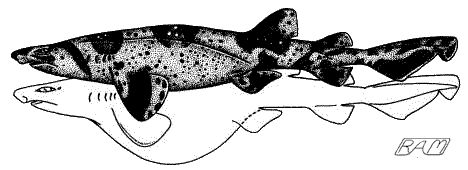Thar She Blows!
In a few species, the shark stomach is more than a simply place to store food until it can be passed to the intestines for digestion. Like other sharks, Sandtigers (Carcharias taurus) are more dense than water and tend to sink if they stop swimming. But Sandtigers, it turns out, are able to achieve near-neutral buoyancy by gulping air at the surface and holding it in the forward part of the stomach. This air gulping behavior has actually been seen in aquarium specimens, and only later (when divers knew what to look for) was it verified that Sandtigers do the same thing in the wild. There are even reports that captive Sandtigers sometimes expel gas from the cloaca, and it has been suggested that they may be able to fine-tune their buoyancy in this manner. This seems rather dubious. But perhaps the notion that sharks, like humans, pass gas on occasion can help foster a sense that they are really not all that different from us.

Even more dramatic are the swellsharks or balloonsharks of the genus Cephaloscyllium. Like pufferfishes, these smallish (1.5 to 3 feet, or 50 to 100 centimetres, long), slow-moving sharks can inflate rapidly, increasing their diameter up to twice normal size by pumping large volumes of water into the forward portion of the stomach. Presumably this sudden increase in apparent size may startle or discourage a would-be predator, enabling the globular shark to make good its escape. Clearly, this neat trick doesn't always work — a Balloon Shark (Cephaloscyllium sufflans) was recently removed from the stomach of a coelacanth. The Swell Shark (Cephaloscyllium ventriosum), a common species off central to southern California, goes one step farther: when threatened, this species dives into any available rocky crevice, bends its body into a sharp U-shape with head and tail innermost, inflates its body by gulping seawater, then grasps its caudal fin in the mouth. This maneuver presents to the outside world a sharkskin innertube that — rounded and wedged securely into place — is difficult to bite or otherwise forcibly evict.
If caught and hauled to the surface rapidly, swell sharks may inflate with air instead of water — which works just as well but is noisier to expel afterward. There are reports that the Draughtsboard Shark (C. isabellum) from New Zealand actually barks like a large dog. This sound may be due to air escaping explosively past the sphincter which controls the passage of food in and water or air in and out of the stomach. It is difficult to resist imagining a solitary Maori fisherman, paddling shoreward after a successful night's fishing on a moonless night . . . when suddenly, inexplicably, a hoarse barking like an agitated St. Bernard erupts from somewhere in the bow, just beyond his feet where his vision cannot penetrate the darkling light.
